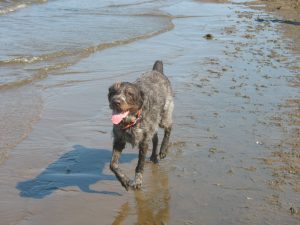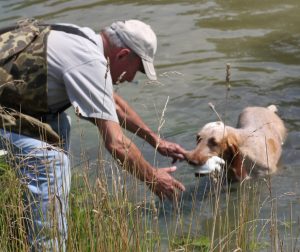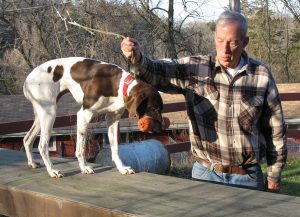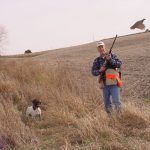Pointing Dogs – Water Dogs?
POINTING DOG POINTERS October 2018
By Bob and Jody Iler
Some years back, we hunted grouse in Wisconsin, marking our way alongside the high bank of a fast flowing river to our right. A grouse flushed in the deep woods to our left and flew directly overhead, silhouetted for just a moment in the blue sky that opened directly above us. As the shot was fired, the grouse crumpled and went down over the river.
We were hunting with three of our dogs, two German shorthairs and a German wirehair. All three ran to the riverbank and watched the bird as it was carried swiftly downstream. The two shorthairs looked at each other, as if to say, “You want to go get it?” and “Nope, why don’t you go get it?” As they debated, our wirehair leaped off the bank into the river and swam out to fetch the grouse and bring it back to us. Those grouse tail feathers still hang over a picture in our office today.
As a pointing dog enthusiast and hunter, sometimes birds are shot that go down in the water. Pheasants, quail, or chukars can end up falling into marshes, creeks, sloughs, or rivers. If your dog doesn’t like the water, it can mean lost birds.
Our opening example was not meant to imply that certain pointing dog breeds like the water better than others and will better retrieve birds in water. However, dogs that are known as “versatile pointing dogs” or “fur and feather” dogs will generally be more all-around hunters that take well to water and retrieving. Note here that we are talking about three main issues: proper introduction to water, learning to swim, and learning to retrieve in water (if pup is not a natural retriever).
Whatever your preference for a particular pointing dog breed, once you get your pup, it makes sense to include gentle introduction to water as part of your training program. Just like people, some pups will like the water more than others. It’s important to start small and keep it positive and fun. A word of caution here: NEVER throw a young pup into the water so that he’ll “learn to swim.” This will frighten the pup and set you way back if you want to have a dog that retrieves in the water!
By starting small, we mean water no deeper than a shallow puddle or tiny creek that a pup can run through while playing. For the pup that just dips a paw in the water and wants to retreat, you can try to engage him with a small dummy or toy that he likes and plays with. Toss it to the edge of the water, and then in or across the water, making it a game. Another approach is to walk with the pup across the water, encouraging pup as you go through but not making a big deal out of it. The goal is to be matter of fact about the water, but it won’t hurt to praise and encourage at this early stage.
As water introduction progresses well, try to find a creek or small pond where the pup can get used to deeper water and still keep his footing. We often use a small creek that varies in size and depth (depending on rainfall) to help pups get used to water. As they run about in the field and have fun, we’ll cross the creek to the other side and continue on our way. Because they want to stay with us, most pups will cross the creek to get to us and soon learn, on warm days, to splash and cool off in the creek too.
Once your pup is used to the water and enjoying it, you’re ready to introduce him to swimming. Small ponds or lakes that don’t have immediate drop offs are perfect for this. Pup can run into the water and still keep his footing while debating about taking the plunge and trying to swim. For this part of the training you will want to go in the water with him, going deeper to encourage him to come to you and start swimming. Initially pup will splash and paddle awkwardly with his front legs coming out of the water. Soon, he’ll learn to lower his head, keep his legs under him, and swim strongly.
Pups that already like to retrieve naturally will often venture out over their heads to go after a favorite dummy. Don’t throw it out very far, though! Take it a step at a time and your pointing dog pup will feel confident as a “water dog.” Another word of caution here: we live close to the Mississippi River, where there are many drop offs, with currents strong enough to overcome the best human swimmers. Always make sure to work in a safe water area and use caution and common sense.
Obviously, the dog that doesn’t retrieve on land is not going to retrieve in the water, so retrieving in water should only follow successful retrieve training on land. Since you’ve properly introduced your dog to water and swimming at an earlier age, the transition to water retrieves after he’s learned to fetch shouldn’t be difficult. Start with a dummy thrown out several yards into the water, and keep the dog on a checkcord so you can guide him back to you (if necessary) after he grabs the dummy. As with most training sessions, one or two successful water retrieves are enough in a given session. Once he’s got the idea, graduate to a shackled or hobbled pigeon or gamebird, tossed out fairly close to shore. Again, use the checkcord to make sure he brings the bird right back to you.
If you have a versatile pointing dog and plan to hunt waterfowl as well as upland game, you may want to get your dog used to decoys. Some dogs will come back with a decoy rather than the duck, so this training can be beneficial. Start out on land with several decoys set out in an area. Walk your dog through the decoys. If he shows a lot of interest in them or tries to pick one up, give him a sharp jerk on the lead with an emphatic “NO!” Repeat for several sessions. If all goes well, have him make several retrieves by throwing a dummy near the decoys, then among them, and finally, past them so he has to run through the decoys to make the retrieve. Ducks can fall anywhere so this is good training for him. You can try this on both land and water, also graduating eventually to using a shackled duck to make it more realistic.
We don’t always think of our pointers and setters as “water dogs,” but if you invest time and effort in helping your dog to like the water, you’ll be rewarded when your young pointing dog drops the retrieved wet bird into your hand, while you stay dry!








